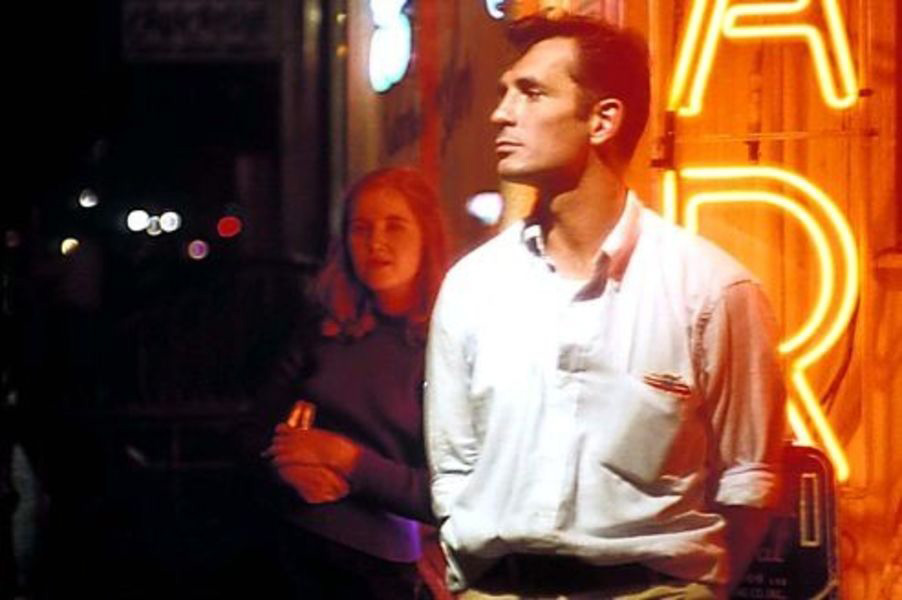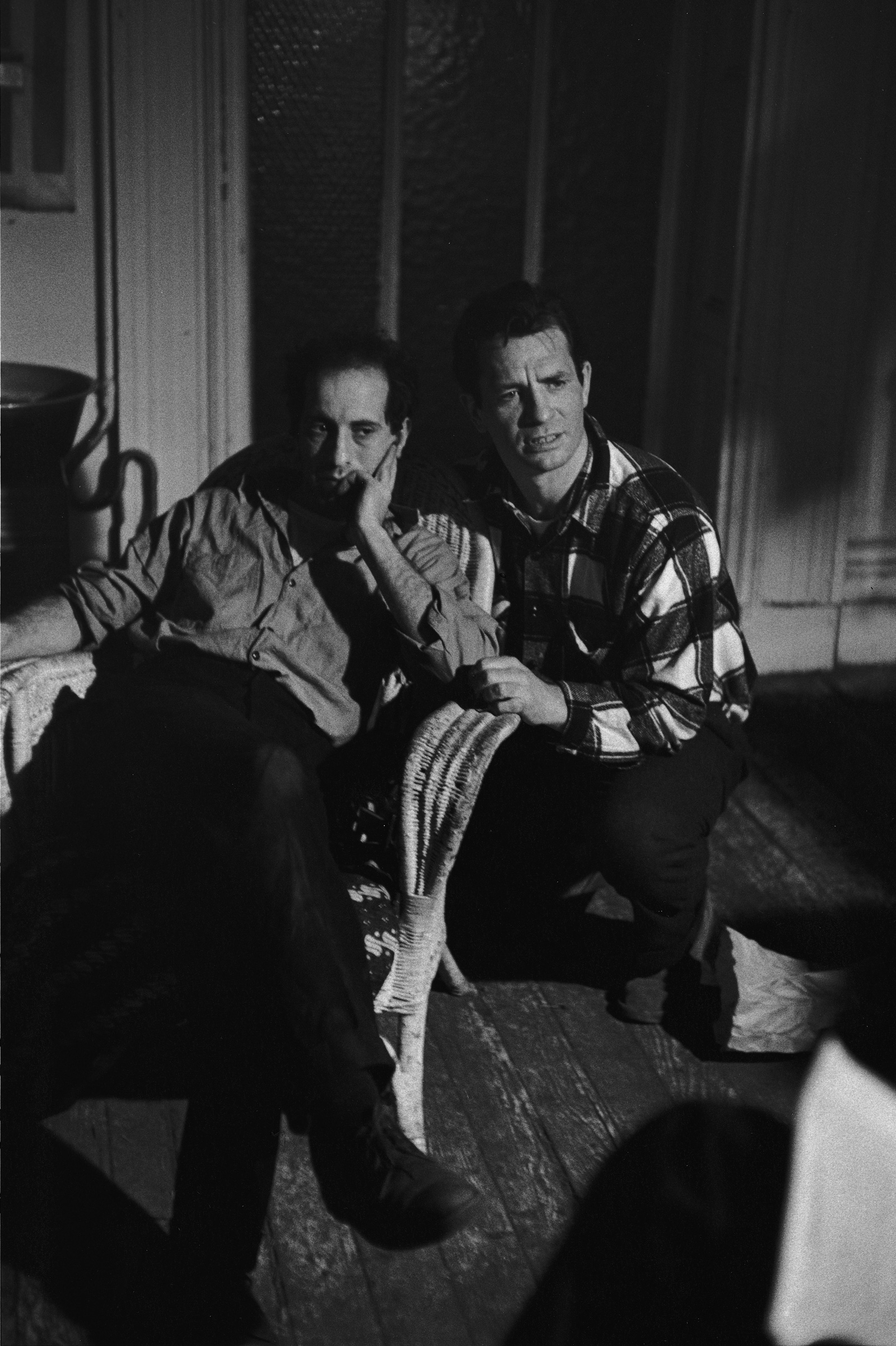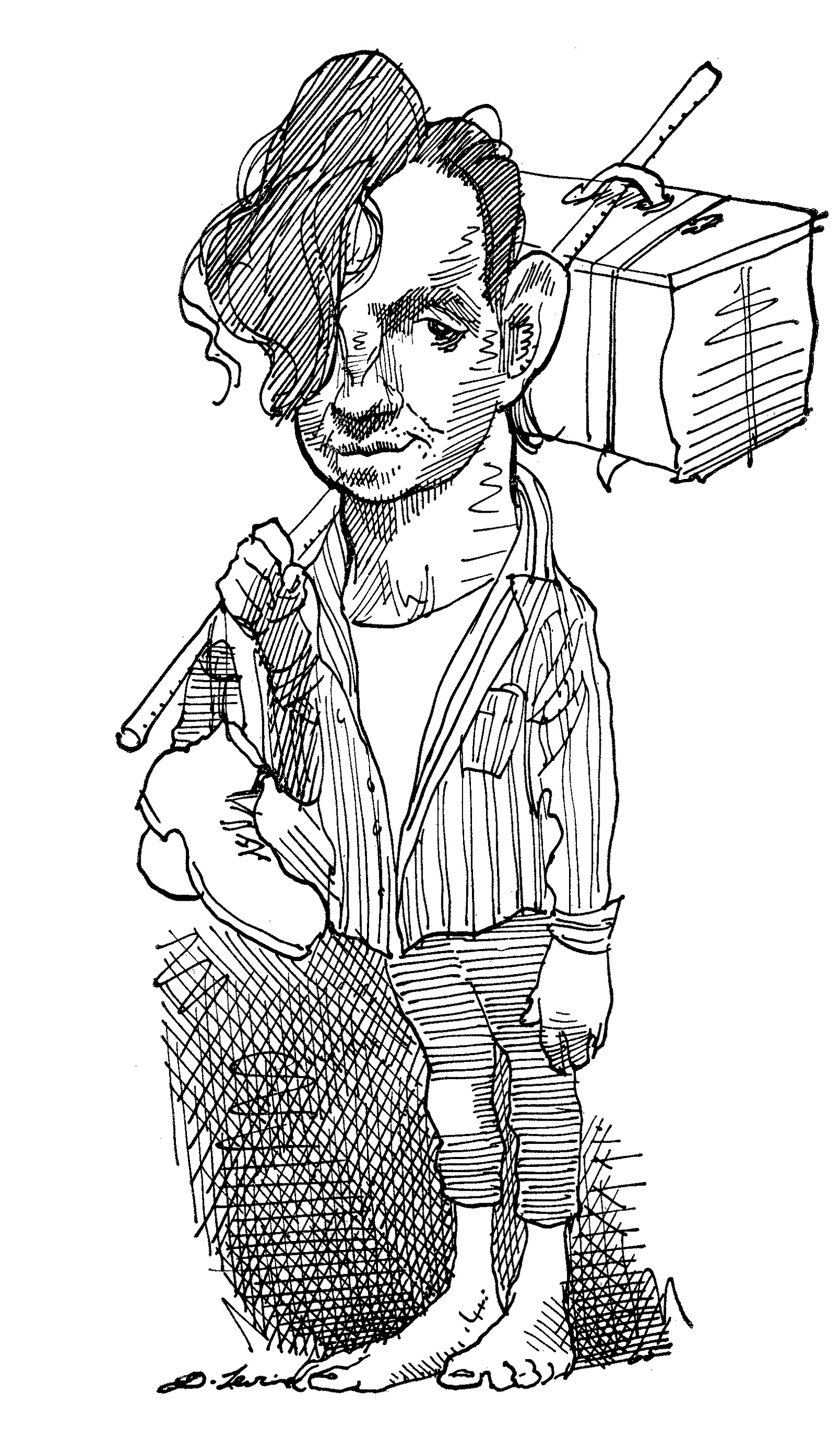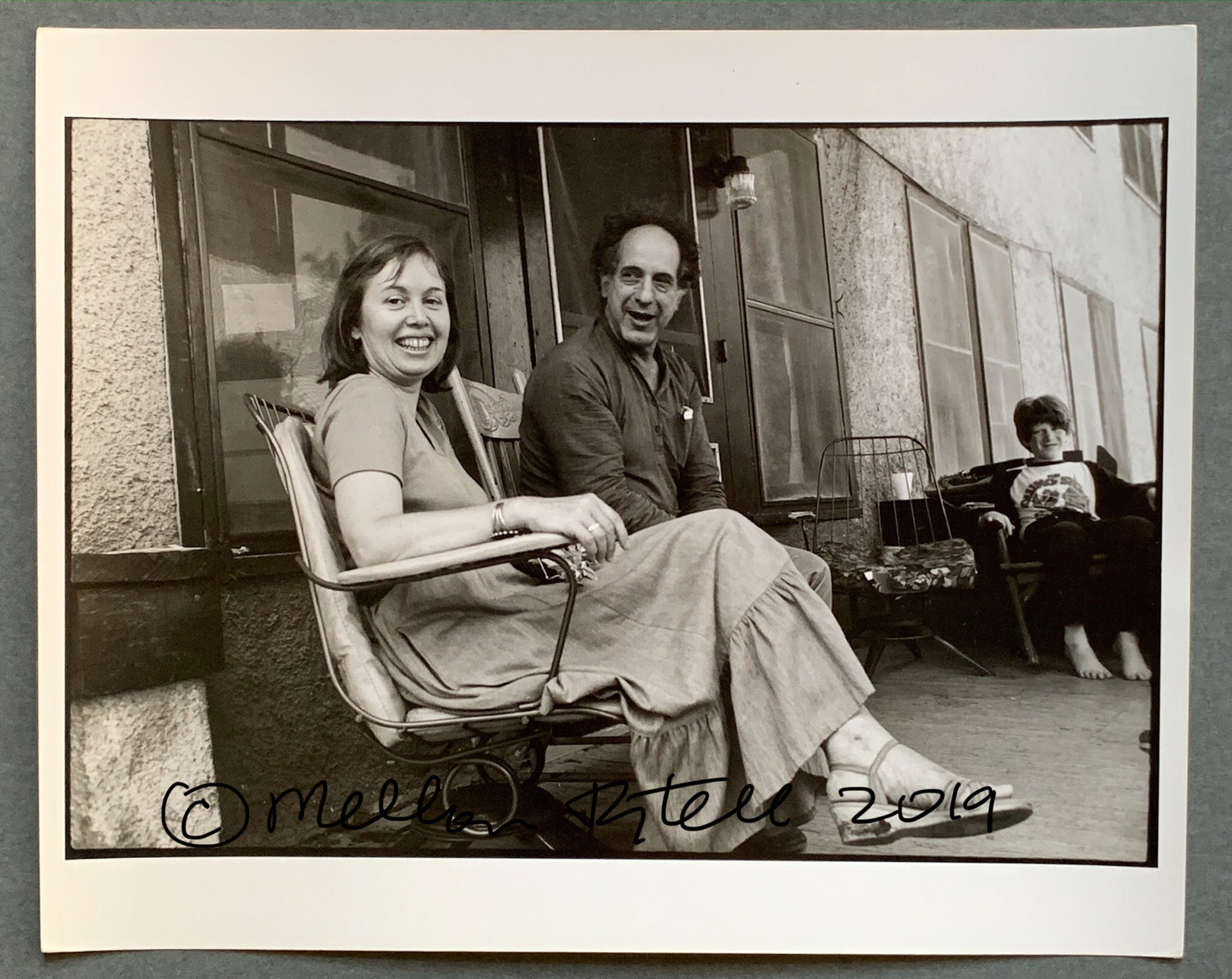It was the fall of 1957, shortly after the publication of On the Road. Jack Kerouac was my boyfriend then, and I was very young. I was sitting in the waiting room of the Viking Press while Jack conferred with his editors. The elevator doors opened and a small, thin man, shabbily dressed and wearing sandals, walked out of the elevator carrying a large portfolio. He had a head of unruly hair that sprang straight up from his forehead and the kind of face you might expect to see in a café in a foreign movie. His accent, as he spoke to the receptionist, matched his face. He was Robert Frank, and he needed to be put in touch with Jack Kerouac, he said, so that he could show him some photos.
I listened to the receptionist giving him a hard time. Publishers’ offices were buttoned-up places in the Fifties with a cultivated air of WASP gentility; a man who showed up at one of them had to wear a suit. I had noticed that Jack’s editors treated him a little like a performing bear. He usually had a few drinks before he saw them. And despite the decade during which New York had been the base for his peripatetic life, he still looked as though he had just stepped out of the Northern woods. I felt that the Frenchman (I found out later he was Swiss) with the sandals and the portfolio could be a kindred Beat spirit, so I decided to speak up. “Jack’s here today,” I told him. “He’ll be out in a few minutes. Would you show me what’s in your portfolio?”
Robert sat down beside me and opened it up. The black-and-white prints it contained immediately reminded me of Jack’s word pictures in On the Road. Here was the reality beyond the sidewalks of New York that I hoped to see one day with my own eyes, if only Jack would take me along on one of his cross-country road trips. I didn’t know that he was becoming far too famous to make them anymore.
Years later, the images I saw that day would become famous themselves: the trolley in New Orleans with the lineup of white and black faces in its windows that told the story of Southern segregation; the displaced Western cowboy propped against a Manhattan garbage can as he tries to light his cigarette; the unforgettably stony expression of a lunch-counter waitress in Hollywood; the smooching sunbathers taking their poor man’s holiday in the shade of their parked cars; the self-satisfaction of a bunch of fur-draped matrons drinking cocktails; the glowing opulence of a jukebox in bleak surroundings. Flags and cars were recurring motifs, as were television sets playing unwatched and roadside crosses (cars were associated with death as well as restless motion). When I came to the empty highway in New Mexico, with its mysterious radiance and its white stripe leading toward some vanishing point in the descending dusk, I thought to myself, Wow! There’s Jack’s Road!
The photos were darkly beautiful, but not pretty. Because of the feeling I had as I looked at them, of all my senses lighting up, I knew that they were great, though I couldn’t have said exactly why. “Jack has to see these,” I told Robert.
As soon as Jack came out of his meeting, I introduced them. After doing his own excited looking, Jack agreed then and there to write the introduction for the book Robert had put together, which would be called The Americans.
Robert Frank, his first wife, Mary, and their two children lived at the time in a small loft in an old rundown building on Third Avenue, not far from my apartment on East 13th Street, where Jack was staying, and we soon got into the habit of dropping over to see them. It was the first artist’s loft I’d ever visited. I was impressed by its bareness. There were some painted wooden chairs, an old round oak table around which the Franks entertained their many artist friends, a potbelly stove, and a notable absence of anything upholstered. By way of décor, a flourishing spider plant sent out its runners. Much of the loft was occupied by Robert’s work. Strips of the thousands of shots he had taken for The Americans, which he had narrowed down to eighty-three for the book, hung from the walls.
In some parts of the country, the sight of a stranger taking so many pictures had aroused the suspicions of the police. In Detroit, where he had been spotted hanging out in a black neighborhood with locals, Robert had been locked up for loitering, he told us. In Little Rock, the cop who arrested him thought he was a Communist. Jack had his own stories to tell about the insides of jails.
Advertisement
In one small corner of the loft, Mary Frank carved her sculptures out of heavy blocks of wood. She was only a little older than I was, having married Robert right out of Music and Art High School. Robert had taken her and their tiny son and baby daughter along with him on parts of his epic journey all around America. I had seen their exhausted faces in one of Robert’s shots. Peering out the dust-streaked windows of their beat-up old car in Del Rio, Texas, Mary and her kids looked like a migrant family in flight.
I envied her those grueling trips with her husband. That summer, I had almost joined Jack in Mexico City, but he’d left there after an earthquake just as I’d scraped together the money for a plane ticket. Instead, he’d decided to come up to New York for the publication of his novel, even though he’d fantasized that the two of us would be far away from that event in some remote Mexican village. Jack thought that with his guidance and enough life and travel experience, I too might eventually be able to write a “big book.” On the other hand, convinced that, like all women, what I really wanted was motherhood, he believed that having babies would put an end to my development as a writer. I noticed, however, that Mary’s children had not stopped her from working. They were wild, entrancing little kids in constant mischievous motion. I offered to babysit. The night I did, they tied me up.
*
In those days, New York was still a city best photographed in black and white. There were pawnshops and cut-rate barbers and the Variety Theater, where bums went to snooze through double features. Two years earlier, the Third Avenue El had been torn down, but the Franks’ neighborhood was not yet free of the shadows cast by its brooding iron structure. It was underneath the El that Jack, in his wanderings on the Bowery in 1951, had developed the spontaneous writing technique he called “sketching,” that he would put to use in some of the books he wrote after On the Road. He’d taught himself to absorb the sights and feeling of a particular scene by willing himself into a state of heightened awareness as if he were taking a mental snapshot, making no attempt to alter or improve upon his raw impressions as he quickly jotted them down in a notebook and later transcribed them directly into his novel Visions of Cody. Robert’s photos also had that unmediated quality that establishment critics in the Fifties so disapproved of. But Jack realized that Robert could do things with his camera that he could never do with language. Light, captured at the right moment, indelibly established the mood in each of Robert’s photos. Mood, Jack had come to believe, was what readers of novels would chiefly carry away with them.
“The picture of a chair in some café with the sun coming in the window and setting on the chair in a holy halo I never thought could be caught on film much less described in its beautiful visual entirety in words,” Jack wrote in his introduction to The Americans. Near the essay’s end, he gave his new friend his highest compliment: “You got eyes.”
Jack’s admirers have called his writing as “American as apple pie,” but that label is misleading in its simplicity. Despite the fact that he had been born in Lowell, Massachusetts, he considered himself only “half-American,” as he wrote in a 1945 diary entry. “All this American richness,” he wrote after walking past the backyard Labor Day feasts in his Queens neighborhood, “not for the likes of me.” As a Franco-American he felt as much an outsider in this country as Robert, who was born in Zurich in 1924, did.
In the 1880s, Jack’s French-Canadian grandparents had joined the flood of desperate refugees from the hardscrabble farms of northern Quebec who poured into New England’s mill towns. Jack was one of the few young people with that heritage to leave their French-speaking enclaves in the 1940s and take the very lonely journey into the mainstream. Brutal high school football games that may have caused lasting brain damage won Jack the scholarship to Columbia that was his ticket out of Lowell, with its looming factories. There were reasons why he identified so strongly with the poor, the rootless, and the oppressed. In one revealing passage in On the Road, Jack’s autobiographical narrator, Sal Paradise, whom he disguised as an Italian (his concealment of his own ethnic identity later made him ashamed) chides himself for his “white ambitions.” But if you listen closely to the unique music of Sal’s voice, you can hear the cadences of the French-Canadian language that Jack grew up speaking.
Advertisement
After Robert’s father was stripped of his German passport during Robert’s childhood in Geneva, the family went through agonizing uncertainty until he was granted Swiss citizenship. By the time Robert was in his teens, Jewish families like the Franks were being rounded up just over the Swiss border and sent to concentration camps. When World War II was over, Robert decided he no longer wanted to live in Europe; he’d landed in New York at the age of twenty-three, a decade before he met Jack.
The special clarity that can be achieved through a pervasive sense of otherness was something Jack shared with Robert. Both contributed to the real richness of America by being artists who understood that the feeling of exclusion is as American as apple pie.
Ordinarily, Jack was shy around new people, but he opened up to Robert right away. With Allen Ginsberg away in Paris that fall, Robert quickly became his new brother. I found something formidable about Robert, a rigor and sternness that co-existed with his warmth and playful humor. I was never quite sure he approved of me. He made me feel I had not been sufficiently tested. Maybe he thought no girlfriend of Jack’s would be around for very long.
The two of them talked a lot about making movies together. The Hollywood producer Jerry Wald was considering doing a film version of On the Road, although he felt not enough happened in it. Jack disagreed. Ideally, the film would consist of two guys sitting in a car talking to each other. Ideally, Sal Paradise, would be played by an actor with the qualities of Jean Gabin. Ideally, it would be a French movie shot in America by Robert. I’m sorry they never got to make it.
Meanwhile, Jack was crumbling in the glare of the spotlight that had been focused on him ever since the extraordinary review by Gilbert Millstein in The New York Times. Comparing On the Road to Hemingway’s The Sun Also Rises, Millstein had made Jack famous overnight as the voice of his generation. But a deluge of attacks immediately followed. Affronted critics found Jack’s take on America a threatening invitation to juvenile delinquency. Why write about such lowlife, worthless people? The barbarians were surely at the gates. In 1959 Robert would receive similar reactions to The Americans: too bleak and too ugly. There have always been penalties for artists who break rules. What Jack found especially painful was the belittling of his prose.
“I don’t know who I am anymore,” he told his old friend John Clellon Holmes. He had lost something more essential to him than he’d ever realized, his invisibility—the irreplaceable anonymity that had enabled Robert to move through the American landscape with his camera with “the strange secrecy of a shadow,” as Jack wrote in his introduction. Later, as Robert’s own fame grew, Robert would turn inward, his subjects becoming more intimate and personal.
In the spring of 1958, Jack and Robert went on the road trip they had been planning, heading south in Robert’s car to Orlando, Florida, where Jack’s mother lived, so that Jack would have the opportunity to watch Robert at work. Jack did not invite me along, but he left me a terrific note scrawled on a yellow typewriter paper label: “Gone on the road. Robert woke me. You are my angel in a pink slip.” As I read that last line, I was sure we had never been closer, but he never really came back to me after that.
Shortly before leaving, he had been physically assaulted outside a Greenwich Village bar. After having his head pounded against the pavement, he never felt the same about New York City. Soon after his return, he holed up in a house in Northport, Long Island, with his mother and failed to make progress on a novel about his boyhood he intended to call Memory Babe. His extraordinary ability to tap into his memory had always been vital to his work , but in a dispirited letter that summer, he told me he had “lost all will to remember details.” His visits to me became rare and there were always too many other people around and too much drinking for anything good to happen.
We had already stopped seeing each other when he came into town that winter to narrate Robert’s film Pull My Daisy. It had been shot like a silent movie and featured Allen Ginsberg and other Beat artists playing themselves, gathered in the loft of a friend to talk and goof around until the wife of the host, given a voice for the first time in the entire film, blew up at her husband and threw all of them out. Nothing really happened, yet everything did. Jack amazed everyone by extemporaneously reeling off the entire soundtrack, including improvising dialogue for each of the characters, in one sitting. Despite the fact that he was completely drunk, his words and voice were the perfect match for the rough-hewn poetry of Robert’s cinematography.
When I saw the film, I detected echoes in the wife’s furious outburst of my own incoherent rage during the fight I’d finally had with Jack outside the Italian restaurant where we’d been eating with the Franks and a woman Jack had been flirting with who was clearly primed to take my place. “You’re nothing but a big bag of wind!” I’d yelled at him, too full of grief and grievance to come up with anything more to the point.
I caught a glimpse of him that New Year’s Eve blindly staggering along Second Avenue in the midst of falling snow with Allen Ginsberg and Peter Orlovsky, a scene I described in my memoir. I felt the urge to run and catch up with him, but I was with someone else and on the other side of the street.
Joyce Johnson’s Minor Characters: A Beat Memoir includes more about her time with Jack Kerouac. Mellon Tytell is working on a book of photographs about her thirty-seven-year friendship with Robert Frank, called Shooting Each Other: Robert Frank and Me.






